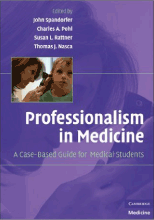
|
|
Spandorfer J, Pohl C, Nasca T, Rattner SL, eds. Professionalism in Medicine : A Case-Based Guide for Medical Students. Cambridge: Cambridge University Press; 2010.
|
| Thomas Jefferson University |
Video: Commitment to Patient Confidentiality | Commentaries
A Medical Student Perspective
As medical professionals, we balance benefit and risk every day in our efforts to help patients while doing them no harm. Every clinical action--every test, every intervention, every piece of advice--is a human one and bears the potential to harm as well as the possibility to help. Sharing information is a necessary risk in medicine. Patients share a wealth of sensitive data about their bodies and their lives so that we may fully understand their health problems and diagnose and treat them properly. In doing so, they trust that we will handle their confidences with the utmost respect for the hurt, embarrassment, and personal, professional, and financial catastrophe that their disclosure might cause.
Each time confidential information goes beyond the physician-patient covenant, the possibility of breach and resultant harm is amplified, but clearly some disclosure is necessary. Medicine is a team endeavor--patient data must be shared freely with nurses, staff, and other physicians in order to deliver the highest quality integrated care. All members of the team are similarly sworn and legally bound to maintain patient confidentiality. The flow of information within the team is necessary to benefit the patient.
In the above scenario, however, the students are privy to patient information for the benefit of their education, and they reveal details in front of a non-medical friend. It is clear that sharing in this situation is not for the purpose of helping the patient. It is unclear, though, whether the students in the vignette have revealed anything identifying about the patient. Patient confidentiality is only breached if the listening party can connect the material to an individual. Unfortunately, discerning how much can be revealed without compromising patient confidentiality is tricky, and is it worth the risk if there is no possibility or intention to benefit the patient?
Although discussing patients outside the professional context is inherently risky, I believe it is unrealistic to expect medical professionals never to speak about their work outside of the office or hospital. We must all cope with the emotional consequences of our professions, and healthcare workers have the special burden of dealing with issues of life and death every day. In addition, I believe it is integral to our own wellbeing that we are able to share our experiences with our loved ones to maintain our personal relationships and support systems. Ultimately, essential to ensuring that we are fit to take care of patients is taking care of ourselves.
The challenge then is how to talk about our professional lives without jeopardizing patient privacy. It is a difficult undertaking; often it is hard to predict what number of details will be identifying, as outsiders might already be familiar with some cases from the news or through connections in the community. The struggle to find a solution, however, is worthwhile. In my own experience, physicians and medical students handle this quandary in ways that span the spectrum, with some choosing to share whole case reports with loved ones, excerpting only the patient's name, and others exercising varying tactics of discretion. Institutions, therefore, would serve their healthcare workers and patients both by working with practitioners to achieve more uniform approach. A realistic set of guidelines would acknowledge that clinicians are humans with personal lives of their own while helping them guard their patients' privacy as strictly as possible.
Amanda Lerman
Medical student, Jefferson Medical College